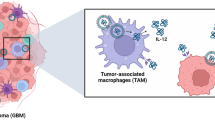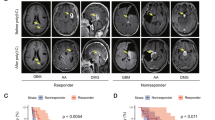Abstract
Purpose
Glioblastoma (GBM) is the most common and malignant primary adult brain tumor. Current care includes surgical resection, radiation, and chemotherapy. Recent clinical trials for GBM have demonstrated extended survival using interventions such as tumor vaccines or tumor-treating fields. However, prognosis generally remains poor, with expected survival of 20 months after randomization. Chemokine-based immunotherapy utilizing CCL21 locally recruits lymphocytes and dendritic cells to enhance host antitumor response. Here, we report a preliminary study utilizing CPZ-vault nanoparticles as a vehicle to package, protect, and steadily deliver therapy to optimize CCL21 therapy in a murine flank model of GBM.
Methods
GL261 cells were subcutaneously injected into the left flank of eight-week-old female C57BL/6 mice. Mice were treated with intratumoral injections of either: (1) CCL21-packaged vault nanoparticles (CPZ-CCL21), (2) free recombinant CCL21 chemokine empty vault nanoparticles, (3) empty vault nanoparticles, or 4) PBS.
Results
The results of this study showed that CCL21-packaged vault nanoparticle injections can decrease the tumor volume in vivo. Additionally, this study showed mice injected with CCL21-packaged vault nanoparticle had the smallest average tumor volume and remained the only treatment group with a negative percent change in tumor volume.
Conclusions
This preliminary study establishes vault nanoparticles as a feasible vehicle to increase drug delivery and immune response in a flank murine model of GBM. Future animal studies involving an intracranial orthotopic tumor model are required to fully evaluate the potential for CCL21-packaged vault nanoparticles as a strategy to bypass the blood brain barrier, enhance intracranial immune activity, and improve intracranial tumor control and survival.



Similar content being viewed by others
References
Stupp R et al (2005) Radiotherapy plus concomitant and adjuvant temozolomide for glioblastoma. N Engl J Med 352(10):987–996
Weller M et al (2017) Rindopepimut with temozolomide for patients with newly diagnosed, EGFRvIII-expressing glioblastoma (ACT IV): a randomised, double-blind, international phase 3 trial. Lancet Oncol 18(10):1373–1385
Liau LM et al (2018) First results on survival from a large phase 3 clinical trial of an autologous dendritic cell vaccine in newly diagnosed glioblastoma. J Transl Med 16(1):142
Stupp R et al (2017) Effect of tumor-treating fields plus maintenance temozolomide vs maintenance temozolomide alone on survival in patients with glioblastoma: a randomized clinical trial. JAMA 318(23):2306–2316
Voth B et al (2015) Transferrin receptors and glioblastoma multiforme: Current findings and potential for treatment. J Clin Neurosci 22(7):1071–1076
Sharma S et al (2013) CCL21 chemokine therapy for lung cancer. Int Trends Immun 1(1):10–15
Warnock RA et al (2000) The role of chemokines in the microenvironmental control of T versus B cell arrest in Peyer's patch high endothelial venules. J Exp Med 191(1):77–88
Willimann K et al (1998) The chemokine SLC is expressed in T cell areas of lymph nodes and mucosal lymphoid tissues and attracts activated T cells via CCR7. Eur J Immunol 28(6):2025–2034
Kar UK et al (2011) Novel CCL21-vault nanocapsule intratumoral delivery inhibits lung cancer growth. PLoS ONE 6(5):e18758
Sharma S et al (2000) Secondary lymphoid tissue chemokine mediates T cell-dependent antitumor responses in vivo. J Immunol 164(9):4558–4563
Novak L et al (2007) Characterization of the CCL21-mediated melanoma-specific immune responses and in situ melanoma eradication. Mol Cancer Ther 6(6):1755–1764
Yousefieh N et al (2009) Regulated expression of CCL21 in the prostate tumor microenvironment inhibits tumor growth and metastasis in an orthotopic model of prostate cancer. Cancer Microenviron 2(1):59–67
Liang CM et al (2007) Local expression of secondary lymphoid tissue chemokine delivered by adeno-associated virus within the tumor bed stimulates strong anti-liver tumor immunity. J Virol 81(17):9502–9511
Baratelli F et al (2008) Pre-clinical characterization of GMP grade CCL21-gene modified dendritic cells for application in a phase I trial in non-small cell lung cancer. J Transl Med 6:38
Stephen AG et al (2001) Assembly of vault-like particles in insect cells expressing only the major vault protein. J Biol Chem 276(26):23217–23220
Wu A et al (2008) Persistence of CD133+ cells in human and mouse glioma cell lines: detailed characterization of GL261 glioma cells with cancer stem cell-like properties. Stem Cells Dev 17(1):173–184
Lai CY et al (2009) Vault nanoparticles containing an adenovirus-derived membrane lytic protein facilitate toxin and gene transfer. ACS Nano 3(3):691–699
Champion CI et al (2009) A vault nanoparticle vaccine induces protective mucosal immunity. PLoS ONE 4(4):e5409
Hardee ME et al (2012) Resistance of glioblastoma-initiating cells to radiation mediated by the tumor microenvironment can be abolished by inhibiting transforming growth factor-beta. Cancer Res 72(16):4119–4129
Morin-Brureau M et al (2015) Enhancement of glioma-specific immunity in mice by “NOBEL”, an insulin-like growth factor 1 receptor antisense oligodeoxynucleotide. Cancer Immunol Immunother 64(4):447–457
Noor S et al (2010) CCR7-dependent immunity during acute Toxoplasma gondii infection. Infect Immun 78(5):2257–2263
Ploix C, Lo D, Carson MJ (2001) A ligand for the chemokine receptor CCR7 can influence the homeostatic proliferation of CD4 T cells and progression of autoimmunity. J Immunol 167(12):6724–6730
Cyster JG (1999) Chemokines and cell migration in secondary lymphoid organs. Science 286(5447):2098–2102
Gollmer K et al (2009) CCL21 mediates CD4+ T-cell costimulation via a DOCK2/Rac-dependent pathway. Blood 114(3):580–588
Nomura T, Hasegawa H (2000) Chemokines and anti-cancer immunotherapy: anti-tumor effect of EBI1-ligand chemokine (ELC) and secondary lymphoid tissue chemokine (SLC). Anticancer Res 20(6A):4073–4080
Sharma S et al (1997) Multicomponent gene therapy vaccines for lung cancer: effective eradication of established murine tumors in vivo with interleukin-7/herpes simplex thymidine kinase-transduced autologous tumor and ex vivo activated dendritic cells. Gene Ther 4(12):1361–1370
Patel MA et al (2014) The future of glioblastoma therapy: synergism of standard of care and immunotherapy. Cancers (Basel) 6(4):1953–1985
Ooi YC et al (2014) The role of regulatory T-cells in glioma immunology. Clin Neurol Neurosurg 119:125–132
He Q et al (2018) Towards improvements for penetrating the blood-brain barrier-recent progress from a material and pharmaceutical perspective. Cells 7(4):24
Pardridge WM (2005) The blood-brain barrier: bottleneck in brain drug development. NeuroRx 2(1):3–14
Lockman PR et al (2004) Nanoparticle surface charges alter blood-brain barrier integrity and permeability. J Drug Target 12(9–10):635–641
Sharma HS et al (2010) Influence of nanoparticles on blood-brain barrier permeability and brain edema formation in rats. Acta Neurochir Suppl 106:359–364
Author information
Authors and Affiliations
Corresponding author
Ethics declarations
Conflicts of interest
Carlito Lagman was partially supported by a Gurtin Skull Base Research Fellowship. Lawrance K. Chung was partially supported by an AMA Foundation Seed Grant and an AΩA Carolyn L. Kuckein Student Research Fellowship. Isaac Yang (senior author) was partially supported by a Visionary Fund Grant, an Eli and Edythe Broad Center of Regenerative Medicine and Stem Cell Research UCLA Scholars in Translational Medicine Program Award, the Jason Dessel Memorial Seed Grant, the UCLA Honberger Endowment Brain Tumor Research Seed Grant, and the STOP CANCER Research Career Development Award. Isaac Yang is a consultant for Brainlab. The remaining authors report no conflict-of-interests concerning the materials or methods used or the findings specified in this study.
Additional information
Publisher's Note
Springer Nature remains neutral with regard to jurisdictional claims in published maps and institutional affiliations.
Rights and permissions
About this article
Cite this article
Voth, B.L., Pelargos, P.E., Barnette, N.E. et al. Intratumor injection of CCL21-coupled vault nanoparticles is associated with reduction in tumor volume in an in vivo model of glioma. J Neurooncol 147, 599–605 (2020). https://doi.org/10.1007/s11060-020-03479-8
Received:
Accepted:
Published:
Issue Date:
DOI: https://doi.org/10.1007/s11060-020-03479-8




